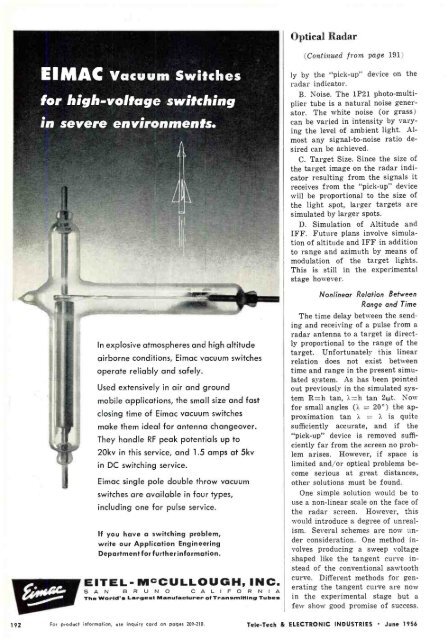TELE-TECH & - AmericanRadioHistory.Com
TELE-TECH & - AmericanRadioHistory.Com
TELE-TECH & - AmericanRadioHistory.Com
You also want an ePaper? Increase the reach of your titles
YUMPU automatically turns print PDFs into web optimized ePapers that Google loves.
F<br />
A<br />
Optical Radar<br />
EIMAC Vacuum Switches<br />
for high- voltage switching<br />
in severe environments.<br />
In explosive atmospheres and high altitude<br />
airborne conditions, Eimac vacuum switches<br />
operate reliably and safely.<br />
Used extensively in air and ground<br />
mobile applications, the small size and fast<br />
closing time of Eimac vacuum switches<br />
make them ideal for antenna changeover.<br />
They handle RF peak potentials up to<br />
20kv in this service, and 1.5 amps at 5kv<br />
in DC switching service.<br />
Eimac single pole double throw vacuum<br />
switches are available in four types,<br />
including one for pulse service.<br />
If you have a switching problem,<br />
write our Application Engineering<br />
Department for further information.<br />
EITEL - McCULLOUGH, INC.<br />
S A N B R U N O C A L I<br />
O R N I<br />
The World's Largest Manufacturer of Transmitting Tubes<br />
(Continued from page 191)<br />
ly by the "pick -up" device on the<br />
radar indicator.<br />
B. Noise. The 1P21 photo- multiplier<br />
tube is a natural noise generator.<br />
The white noise (or grass)<br />
can be varied in intensity by varying<br />
the level of ambient light. Almost<br />
any signal -to -noise ratio desired<br />
can be achieved.<br />
C. Target Size. Since the size of<br />
the target image on the radar indicator<br />
resulting from the signals it<br />
receives from the "pick -up" device<br />
will be proportional to the size of<br />
the light spot, larger targets are<br />
simulated by larger spots.<br />
D. Simulation of Altitude and<br />
IFF. Future plans involve simulation<br />
of altitude and IFF in addition<br />
to range and azimuth by means of<br />
modulation of the target lights.<br />
This is still in the experimental<br />
stage however.<br />
Nonlinear Relation Between<br />
Range and Time<br />
The time delay between the sending<br />
and receiving of a pulse from a<br />
radar antenna to a target is directly<br />
proportional to the range of the<br />
target. Unfortunately this linear<br />
relation does not exist between<br />
time and range in the present simulated<br />
system. As has been pointed<br />
out previously in the simulated system<br />
R =h tan, ì. =h tan 20.)t. Now<br />
for small angles (). = 20 °) the approximation<br />
tan A = ), is quite<br />
sufficiently accurate, and if the<br />
"pick-up" device is removed sufficiently<br />
far from the screen no problem<br />
arises. However, if space is<br />
limited and /or optical problems become<br />
serious at great distances,<br />
other solutions must be found.<br />
One simple solution would be to<br />
use a non -linear scale on the face of<br />
the radar screen. However, this<br />
would introduce a degree of unreal -<br />
ism. Several schemes are now under<br />
consideration. One method involves<br />
producing a sweep voltage<br />
shaped like the tangent curve instead<br />
of the conventional sawtooth<br />
curve. Different methods for generating<br />
the tangent curve are now<br />
in the experimental stage but a<br />
few show good promise of success.<br />
192 For product information, use inquiry card on pages 209 -210. Tele-Tedi & ELECTRONIC INDUSTRIES June 1956
















